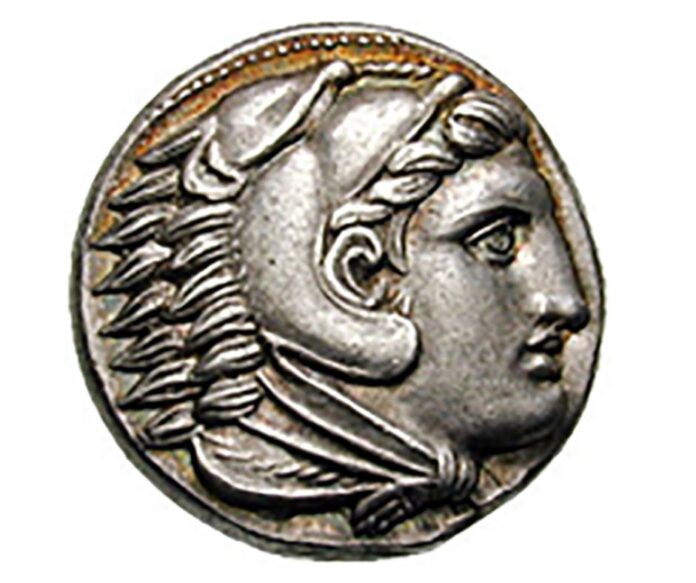
Ancient coins’ value and rarity can be overwhelming with a wide range as these coins were hand struck for over 1,000 years.
Some rare types commemorate major historical moments in the history of western civilization, while others represent the highest levels of artistic and technical achievement in numismatics. Some types are so rare that only a handful survive today, while there are abundant types that can be obtained by most collectors on a firm budget. With some due diligence, any collector can establish the relative value and rarity of most ancient coins.
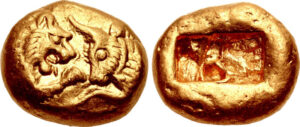
Online Research
One of the best places to start is with online research. This should include checking typical auction sites such as Sixbid.com or Vcoins.com. Sixbid is a popular online coin auction platform featuring many auctions each year from over 100 reputable auction houses all over the world. Tracking and partaking in these auctions is a great way to enjoy the hobby. Vcoins is an online marketplace that features over 130 dealers and over 90,000 ancient coins for sale at any given time. These websites can help collectors determine the approximate value of their coin using online tools to determine the availability of a certain coin type and its approximate range in value.
Another great way to determine value is to attend coin conventions where many top dealers assemble to auction their wares to the general public.
Let’s evaluate some popular ancient coin types from each of the two largest and most abundant groups in ancient numismatics: the Greeks and Romans by considering a few examples that are among the finest coins ever produced in the ancient era.
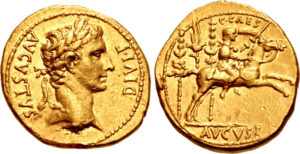
Ancient Greek Coins
Considering Greek coins, let’s start at the beginning in the archaic period and evaluate the first gold coin ever struck and its availability on the market. King Alyattes is often thought of as the first ruler to issue coins in the late 7th century B.C. His son, King Croesus, ascended to the throne in 560 B.C. and was an innovator with his father’s coin system. Croesus would take his father’s invention and refine it further, producing the world’s first gold and silver coinage. Croesus’ coinage became the first bimetallic and interrelated monetary system in the world. The stater seen here reveals an obverse with a lion facing right representing the strength of the Kingdom, and a bull facing left which stood for virility.
This early coinage of Lydia is rare and can fetch a premium depending on overall condition and denomination. A search at Vcoins revealed only one stater and a few smaller 1/6 stater or trites out of 90,000 coins total. An extremely fine gold stater of Croesus can fetch $200,000 while a lower example can demand $20,000. Despite these elevated prices, collectors can still obtain a smaller denomination such as a trite at three grams for $2,000 to $5,000 in fine condition.
Fast forward to the Classical era which many consider the height of ancient Greek Art. A superb example of the coinage during this era is a tetradrachm of Syracuse, struck from 415 to 409 BC. The city-states responsible for issuing the coins hired skillful engravers to create artistic representations of their city. This coin displays a racing quadriga or chariot drawn by four horses on the obverse. Nike, the goddess of victory, is seen flying to the right crowning the charioteer with a wreath. The reverse displays an exquisite rendition of Arethusa, a nymph of a sacred spring within the colony. A search revealed only 33 examples available at Vcoins or 0.04% out of 90,000 coins. A very good example of this coin can be obtained for about $1,000, but the value and rarity rise sharply with condition. A very fine example can often fetch $20,000 or more at auction.
The eventual conquest of Greece by the Macedonian King Philip II and his son Alexander the Great would bring a close to the Classical period, and usher in a new era called the Hellenistic period by Alexander’s death in 323 B.C. Alexander would issue an extensive series of coinage during his reign, including a tetradrachm depicting Herakles on the obverse. The use of Herakles here refers to the lineage of Alexander who claimed that his family had descended from the famed hero. The reverse depicts Zeus, the revered king of all gods and men in Greek mythology. A search revealed only 360 examples available at Vcoins or 0.4% at that specific venue. A very good example of this coin can be obtained for about $200 but can be worth as much as ten times that at $2,000 for a very fine example.
Overall, these famous types of Greek coinage can draw a premium in the current market. Despite that, many Greek examples are reachable for modest collectors. A search on Vcoins showed a large variety of over 700 silver and gold Greek staters available from about $200 to $20,000. Out of the 90,000-coin database for sale at Vcoins, Greek coins represented over 20% with a large portion of those coins ranging from $50 to $500.
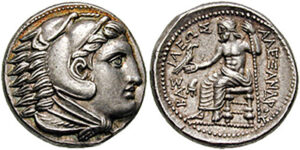
Evaluating Roman Coins
When switching gears to Roman coins, collectors will immediately see a larger volume typically represented by these types. At Vcoins, Roman coins make up about 60% of the total coins available for purchase. Despite the abundance of Roman coins on the market, rare types can still demand a premium at auction.
The coin seen here was issued in the beginning of 44 B.C. and displays Julius Caesar on the obverse with the Latin inscription “CAESAR DICT QVUART” which translated means “Caesar Dictator for the Fourth Time.” This was the first time a Roman leader appeared on their coinage, quite a statement at the time when the Roman Republic was ruled collectively by Consuls and the Senate. The reverse depicts the Roman goddess Juno Sospita, known as the Savior of Rome, a direct tribute to Caesar and his efforts to save the Republic. This coin is one of the rarest Roman coins, with no examples seen at Vcoins and occasionally seen at auction from about $3,000 for a very good example to $60,000 for an example in very fine condition. Despite the rarity of this coin type, silver Roman denarius overall are available on the market. A search revealed over 7,000 denarii of various emperors for sale at Vcoins with many in a price range between $50 to $500.
In the aftermath of Caesar’s death, his great nephew Gaius Octavius (Octavian) became the heir to most of his fortune. During his reign, a large range of types were struck to commemorate his many achievements. He would continue to accumulate various titles and set out to methodically restructure the Roman Republic into a hereditary monarchy. It was the dawn of a new era, and the Roman Empire subsequently began to take shape. By 27 B.C., the Senate had bestowed upon him the honorific title Augustus, or the “Illustrious One.” The coin reveals Augustus on the obverse facing right, with his heir Caius Ceasar on horseback with standards of the Roman army displayed in the background. Roman gold coins can be difficult to find in fine or better condition, with most examples on the market ranging from $3,000 to $100,000.
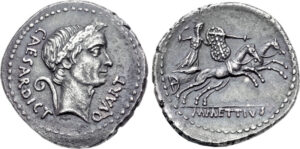
The Ancient Coin Market
Out of the roughly 91,000 coins surveyed, approximately 65% were Roman and 23% were Greek coins. Roman coins are considerably easier to obtain in very fine or better condition compared to Greek coins. A wide range of Roman and Greek silver can be obtained for a modest price between $100 to $400 per coin. A survey of the current market reveals that it is possible to assemble a nice collection at a decent price. By choosing coins in the best condition at the best price, most collectors can build a respectable collection over time that should retain its value in the ancient coin market.
This article about ancient coins value previously appeared in COINage magazine. To subscribe click here. Article by Timothy M. Ryan. All photos courtesy Classical Numismatic Group, LLC, cngcoins.com.












